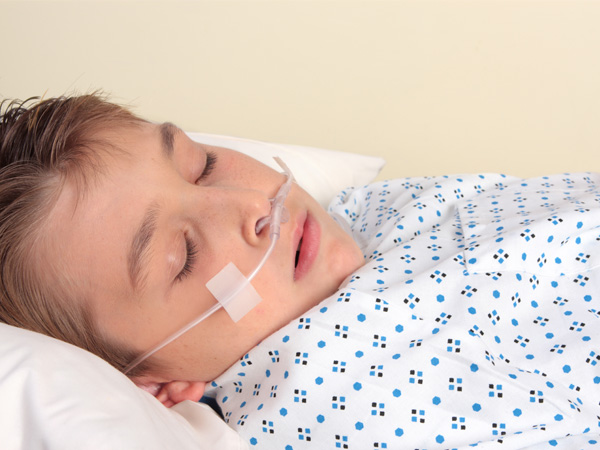- Home
- Science
- Diseases & Conditions
- Pulmonary Hypertension
What Is Pulmonary Hypertension?
Pulmonary hypertension can be understood as high blood pressure in the arteries in the lungs. It happens when the pressure in the blood vessels that run from the right side of the heart to the lungs gets too high.1
The right ventricle of the heart pumps blood to the lungs so that the blood can pick up oxygen and deliver it to the rest of the body. The pulmonary artery that carries blood from the heart to the lungs is very short, so its blood pressure is usually lower than the blood pressure in the arteries that carry blood from the heart to the rest of the body. With pulmonary hypertension, though, the pressure in the pulmonary artery is elevated.1,2
When comparing pulmonary hypertension to hypertension (more commonly known as high blood pressure), there's one big difference. Hypertension can elevate the pressure in arteries all over the body. Pulmonary hypertension only causes an increase in the arteries in the lungs.3
Causes and Risk Factors
What Causes Pulmonary Hypertension?
Pulmonary hypertension can have several causes, including:
- Heart disease
Some heart diseases, including mitral valve disease, left heart disease, and congenital heart disease, may cause pulmonary hypertension.4
- Blood clot
In a condition called chronic thromboembolic pulmonary hypertension (CTEPH), clots in the pulmonary arteries raise blood pressure in the lungs by blocking blood flow.5
- Obesity
Obesity is associated with the development of pulmonary hypertension.6
- Low oxygen
Obstructive sleep apnea is linked to pulmonary hyptertension.7 Living at a higher elevation can also play a role.8
- Other liver, lung, and connective tissue disorders
Underlying conditions, also known as comorbidities, can contribute to the development of pulmonary hypertension.4,9 Examples of conditions that can raise pulmonary hypertension risk include:
- Chronic liver disease, including cirrhosis10
- Emphysema2
- Chronic obstructive pulmonary disease (COPD)4
- Tumors4
- Pulmonary fibrosis11
- Lupus3
- Scleroderma3
- Diet drug fen-phen
This product has been taken off the market, but anyone who used it may have a higher risk of pulmonary hypertension.12
- Genetics
A genetic mutation is responsible for roughly 20% of pulmonary hypertension cases that don’t have other known causes. Most cases of pulmonary hypertension that have genetic underpinnings are tied to the bone morphogenetic protein receptor 2 (BMPR2) gene. This gene regulates the growth of cells in the walls of the small arteries in the lungs. When this gene malfunctions, the arteries narrow, restricting blood flow. Inheriting the genetic mutation doesn't necessarily mean a person will develop pulmonary hypertension.13
Pulmonary Hypertension Risk Factors

Pulmonary hypertension can affect a person at any age. But the risk increases as one gets older, particularly after turning age 75.2 Here are other factors that can increase the risk:
- Being born with XX chromosomes14
- Obesity with obstructive sleep apnea14
- Pregnancy14
- High-altitude location14
- Methamphetamine use14
- Certain types of cancer therapies15
- Infectious diseases, such as HIV and Hepatitis B or C16
- Asbestos or silica exposure17,18
- Smoking tobacco19
Pulmonary Hypertension Prevention
It isn't always possible to prevent pulmonary hypertension. However, there are steps that may reduce the likelihood of developing the condition. Strategies include:
- Keeping high blood pressure under control2
- Managing and monitoring coronary heart disease closely2
- Managing or monitoring chronic liver disease, or chronic lung disease stemming from tobacco use2
- Sticking to a diet that’s conducive to heart health4,20
- Giving up smoking or tobacco use4,19
Types of Pulmonary Hypertension
Healthcare providers use the blanket term “pulmonary hypertension” to describe five types of the disease, each of which has its own cause and name.21
- Group 1: Pulmonary arterial hypertension (PAH)
PAH happens when the arteries to the lungs become damaged without a clear reason. For example, these tiny conduits for blood may become narrower. The narrowing restricts blood flow and elevates blood pressure inside the lungs. This narrowing also taxes the heart, which must use more force to push blood through the arteries.22,23
The right side of the heart must pump harder to overcome this higher pressure and push blood to the lungs. The added effort causes the heart to enlarge over time. The right side of the heart also stiffens, further reducing its pumping capacity. Eventually, the right side of the heart becomes so weak it can no longer adequately circulate blood—a condition called right-sided heart failure.3,22,23
This type of PH has five types of causes. It can be idiopathic in nature, meaning the cause is unknown. PAH also can be genetically inherited, running in families. The use of drugs or illegal substances also may give rise to PAH. Problems with the heart at birth, known as congenital heart disease, can lead to PAH, and so can other conditions, including connective tissue disorders like lupus, scleroderma, and HIV.21
- Group 2: Pulmonary hypertension caused by left-sided heart disease
Group 2 PH stems from left-sided heart valve disease, which includes mitral valve or aortic valve disease.21,24,25 Mitral valve disease involves complications with the valve that separates the heart’s left chambers: the left atrium and left ventricle.24 Aortic valve disease involves problems with the valve situated between the heart’s lower-left chamber (the left ventricle) and the aorta (a major artery).21,25
- Group 3: Pulmonary hypertension caused by lung disease
This PH classification stems from issues with the lungs, including sleep apnea, pulmonary fibrosis (the accumulation of scar tissue between air sacs in the lungs),26 and chronic obstructive pulmonary disease (COPD).21
- Group 4: Pulmonary hypertension caused by chronic blood clots
Blood clots in the lungs, known as pulmonary emboli, and other clotting disorders can lead to this PH classification.5,21
- Group 5: Pulmonary hypertension triggered by other conditions
Group 5 of PH stems from a mix of other diseases and conditions. For example, blood disorders such as polycythemia vera (a type of blood cancer in which the body makes excess red blood cells) and essential thrombocythemia (a blood disorder involving excess production of platelets) can cause Group 5 PH.27,28,29 So can inflammatory disorders such as sarcoidosis, a disease in which pockets of inflammation arise in the body.27,30 Metabolic disorders, such as glycogen storage disease,27 a condition in which the body lacks an enzyme to properly store or use glycogen,31 can lead to Group 5 PH, and so can kidney disease, with some tumors causing clots or physical compression of the pulmonary artery from nearby tissues.27
Pulmonary Hypertension in Newborns
This condition threatens a baby's oxygen supply at birth.32 Approximately two out of every 1,000 infants born at full term have pulmonary hypertension.32 During pregnancy, the mother supplies the baby's oxygen, so the blood vessels in the baby's lungs are closed. After birth, those vessels should open with the first breath. With pulmonary hypertension in newborns, that doesn't happen as it should, and the blood vessels do not fully open. This can deprive the baby’s body (including the brain) of necessary oxygen and can cause heart and lung damage.32
Pediatric Pulmonary Hypertension

Pulmonary hypertension in children may be inherited or it can develop from heart defects present at birth.33 It can also develop due to other conditions, such as cystic fibrosis or impaired heart muscle function.34
Affected children may experience:35
- Decreased appetite
- Vomiting or nausea when eating
- Swelling in the legs, face, or arms
- Inability to tolerate activity
- Pain in the chest, dizziness, or shortness of breath
- Pale or bluish appearance
- Fainting
- Younger children may be underweight
- Older children may gain weight from inactivity or swelling
Portopulmonary Hypertension
This type of hypertension is linked to portal hypertension, a type of elevated pressure in the portal vein located in the liver.36,37 It can happen regardless of whether a person has existing liver disease.36
Pulmonary Hypertension Symptoms

Symptoms of pulmonary hypertension may develop slowly over time. It may take months or years before symptoms are noticeable, as they worsen when the condition becomes more severe.38 Symptoms can include:
- Fatigue4
- Dizziness or fainting2,4
- Shortness of breath from routine activity4
- Chest pain2
- Bluish color in the lips or skin4
- Swelling in the legs, feet, or abdomen38
- Fast or pounding heartbeat2
- Hoarseness38
- Nausea and vomiting38
- Wheezing38
Of course, these symptoms can also occur in diseases other than pulmonary hypertension, which can make the diagnosis of pulmonary hypertension challenging.38 It's important to note that pulmonary hypertension symptoms are different from regular high blood pressure symptoms.38,39 In many cases, high blood pressure doesn't produce noticeable signs or symptoms.39 However, symptoms of high blood pressure can develop when pressures are very high (180/120) and may include:39,40,41
- Nosebleeds
- Bad headache
- Chest pain
- Breathing difficulties
Pulmonary Hypertension Complications
Having pulmonary hypertension may put one at risk for developing additional complications including, but not limited to:
- Blood clots in the pulmonary arteries42
- Liver damage due to higher pressure in the right side of the heart10,42
- Pericardial effusion (fluid collection in the sac around the heart)42
- Anemia (low red blood cell count or low hemoglobin in the blood)42,43
- Irregular heartbeat42
- Bundle branch blocks (delays in the electrical impulse that triggers the heartbeat)44
- Bleeding within the lungs42
- Pregnancy complications, including cardiac arrest, heart attack, respiratory failure, and stroke.45
- Reduced life expectancy45
Diagnosing pulmonary hypertension can be difficult because it isn't immediately obvious during a regular check-up with a healthcare provider.46 Even when signs and symptoms emerge, they can be confused with other problems in the heart or lungs.46
If the doctor suspects that a patient might have pulmonary hypertension, they may recommend these tests to correctly diagnose the condition:46
This picture of the heart, chest, and lungs can reveal any heart or pulmonary artery enlargement.46
Blood tests can check kidney, thyroid, and liver function, as well as blood-oxygen levels.46
This test assesses how the heart’s electrical impulses are functioning. An electrocardiogram alone, however, cannot conclusively diagnose pulmonary hypertension. If a doctor suspects pulmonary hypertension, they will likely perform other tests.46
Echocardiograms use sound waves, delivered at a high frequency, to form images of the heart. These images help healthcare providers assess heart structure and function. For example, an echocardiogram can help identify issues with heart valves, study how well the heart is moving, or gauge the strength of heart beats.46,47
If any of the above tests point to pulmonary hypertension, this procedure can confirm it. A cardiologist will run a thin, flexible tube, called a catheter, through one of the patient’s blood vessels to the heart and pulmonary artery to measure the pressure.46
Pulmonary Hypertension Life Expectancy
Life expectancy differs between pulmonary hypertension groups. Age and gender may help predict a patient’s outlook. One study compared survival rates among groups of people with different types of pulmonary hypertension who did not receive transplants. Overall, average survival rates were about:48
- 86% at 1 year
- 67% at 3 years
- 54% at 5 years
Pulmonary Hypertension Treatments
Except for CTEPH, which sometimes can be reversed by surgery, pulmonary hypertension often cannot be fully cured, but there are several treatments that can improve quality of life for people who have the condition.5 Research indicates that people who are diagnosed early tend to have better outcomes, making early detection and treatment important.49
Pulmonary Hypertension Medications
A number of approaches may be used to treat pulmonary hypertension, including medications and other types of treatments.49 Options include:
- Vasodilators
These medications help the blood vessels open to improve blood flow to the lungs.49 They can be injected, inhaled in a nebulizer treatment, taken by mouth, or delivered by infusion pump.49,50,51 There are several types of vasodilators used to treat pulmonary hypertension. Some of the side effects, depending on the type of vasodilator used, can include nausea, chest pain, and headache.52
The first kind of medication used to treat pulmonary hypertension is a calcium channel blocker. Calcium channel blockers are only effective for some people. When effective, calcium channel blockers lower blood pressure.50,51
Another type of medication used for pulmonary hypertension is guanylate cyclase stimulators. These medications relax the pulmonary arteries with nitric oxide, lowering the pressure in the lungs.51,53 They can cause an upset stomach and/or headache.54 Next, some patients may benefit from endothelin receptor antagonists. These medications counteract endothelin, a substance in the blood vessels that causes them to tighten.49,55 They can cause liver damage, so regular monitoring of liver function is recommended.55
The final type of vasodilator used to treat pulmonary hypertension is phosphodiesterase 5 inhibitors. These medications may improve blood flow in the blood vessels in the lungs.49,56 Some of the side effects include headaches, stomach aches, and flushing.57
- Blood thinners
These medicines, called anticoagulants, can help treat blood clots that cause some cases of pulmonary hypertension.50 They can, however, increase the risk of bleeding.58
- Diuretics
Also known as water pills, these drugs help the kidneys flush extra fluid out of the body.59 Doing so reduces the workload for the heart.60
- Oxygen therapy
Oxygen therapy may be administered if blood-oxygen levels drop too low.50 Patients will typically receive oxygen therapy by wearing a face mask or nasal cannula.50
Surgical Therapies for Pulmonary Hypertension
Some of the surgical therapies for pulmonary hypertension include:
- Pulmonary thromboendarterectomy
This is the surgical removal of existing blood clots found in the pulmonary artery. In some cases, this surgery can help improve lung function.5,21
- Lung or heart-lung transplant
Experts sometimes recommend transplantation; this is usually limited to severe cases of pulmonary hypertension. Transplant recipients take immunosuppressant drugs to lessen the odds of their immune system rejecting new organs.61
Global Impact of Pulmonary Hypertension

Worldwide, between 50 million and 70 million people—nearly 1% of the world's population—have pulmonary hypertension, and that number is expected to grow as the global population ages.62 The lifetime cost associated with healthcare services to treat the condition is high. One study estimates that, in the U.S. alone, PAH creates an economic burden of anywhere from $98,000 to $117,000 per patient per year.63
Pulmonary hypertension is much more common in low- and middle-income countries, such as in Africa and the Middle East. In these locations, the incidence of HIV infection, congenital heart disease, and rheumatic fever, which increase the risk of developing pulmonary hypertension, are also higher.64
There are several challenges to treating patients with pulmonary hypertension in low- and middle-income countries. Diagnosis can take up to three years, and patients have limited access to healthcare services. Medications are scarce, and lung transplant is typically not an option.64
Frequently Asked Questions About Pulmonary Hypertension
- Can pulmonary hypertension be reversed?
With the exception of CTEPH, pulmonary hypertension cannot be cured, but existing treatments may improve quality of life for people who have the condition.5 Treatment options depend on the type of pulmonary hypertension, and sometimes address underlying causes, like heart or lung problems.21,50 For example, if thyroid disease or obstructive sleep apnea is responsible for pulmonary hypertension, addressing those problems can reverse the damage.65,66 In some cases, lifestyle changes, such as smoking cessation and a healthy diet, can help reduce the risk of pulmonary hypertension.2,50
- Is pulmonary hypertension fatal?
Yes, pulmonary hypertension can be fatal. Researchers have said the disease is “characterized” by “diminished life expectancy.”45 Survival rates may vary depending on whether a person receives a transplant, as well as what type of pulmonary hypertension they have.4,48
For example, one study found that the 5-year survival rate for people with incident and prevalent idiopathic pulmonary arterial hypertension who did not receive transplants was 67.1% and 58.9%, respectively. Compare that with the 5-year survival rate of incident and prevalent pulmonary arterial hypertension associated with known causes, which had 5-year survival rates of 56.8% and 39.2%, respectively. In the same study, the 1-year survival rate for these groups ranged from 90.6% to 79.2%.48
- Can pulmonary hypertension go away on its own?
If the underlying condition that causes pulmonary hypertension is identified, then it is possible that the increased pressure may return toward normal with successful treatment.65,67
- Does pulmonary hypertension cause high blood pressure?
While it is possible to have both pulmonary hypertension and high blood pressure, pulmonary hypertension is not a cause of high blood pressure. One can have pulmonary hypertension without high blood pressure, and vice versa.2,3,50
- What causes pulmonary hypertension?
There are several common underlying causes for pulmonary hypertension. Left-sided heart failure, liver disease, connective tissue disease, congenital heart disease, blood clots in the lungs, chronic lung disease, and genetics can all contribute to the development of the condition.21
Explore pulmonary hypertension clinical trials at ClinicalTrials.gov.
Area of Focus: Rare Disease
Pulmonary Hypertension is a focus of Pfizer’s Rare Disease Therapeutic Area. Visit the Rare Disease Page.
- References
- Noncommunicable diseases: Pulmonary hypertension. World Health Organization. https://www.who.int/news-room/questions-and-answers/item/noncommunicable-diseases-pulmonary-hypertension. Updated September 18, 2019. Accessed February 21, 2023.
- Pulmonary hypertension. Centers for Disease Control and Prevention. https://www.cdc.gov/heartdisease/pulmonary_hypertension.htm. Last reviewed December 3, 2019. Accessed February 21, 2023.
- Types of pulmonary hypertension. Pulmonary Hypertension Association. https://phassociation.org/patients/aboutph/types-of-ph/. Accessed February 21, 2023.
- Pulmonary hypertension – high blood pressure in the heart-to-lung system. American Heart Association. https://www.heart.org/en/health-topics/high-blood-pressure/the-facts-about-high-blood-pressure/pulmonary-hypertension-high-blood-pressure-in-the-heart-to-lung-system. Updated October 31, 2016. Accessed February 21, 2023.
- Chronic thromboembolic pulmonary hypertension. American thoracic Society. https://www.thoracic.org/patients/patient-resources/resources/cteph.pdf. Accessed February 21, 2023.
- Frank RC, Min J, Abdelghany M, et al. Obesity is associated with pulmonary hypertension and modifies outcomes. JAHA. 2020;9(5):e014195.
- Yan L, Zhao Z, Zhao Q, et al. The clinical characteristics of patients with pulmonary hypertension combined with obstructive sleep apnoea. BMC Pulm Med. 2021;21(1):378.
- Mirrakhimov AE, Strohl KP. High-altitude pulmonary hypertension: an update on disease pathogenesis and management. TOCMJ. 2016;10(1):19-27.
- Comorbidity. National Cancer Institute. https://www.cancer.gov/publications/dictionaries/cancer-terms/def/comorbidity. Accessed February 21, 2023.
- Nickel NP, Galura GM, Zuckerman MJ, et al. Liver abnormalities in pulmonary arterial hypertension. Pulm circ. 2021;11(4):1-12.
- Ruffenach G, Hong J, Vaillancourt M, Medzikovic L, Eghbali M. Pulmonary hypertension secondary to pulmonary fibrosis: clinical data, histopathology and molecular insights. Respir Res. 2020;21(1):303.
- Bang WD, Kim JY, Yu HT, et al. Pulmonary hypertension associated with use of phentermine. Yonsei Med J. 2010;51(6):971.
- Pulmonary arterial hypertension. MedlinePlus. https://medlineplus.gov/genetics/condition/pulmonary-arterial-hypertension/. Updated January 1, 2016. Accessed February 21, 2023.
- Risk factors. Pulmonary Hypertension Association. https://phassociation.org/patients/aboutph/risk-factors/. Accessed February 21, 2023.
- Javed A, Medina Y, Bux A, Sahra S, Rojas-Marte G. Rare case of reversible pulmonary arterial hypertension secondary to cyclophosphamide and doxorubicin chemotherapy. Cureus. Published online June 22, 2022. Accessed February 21, 2023.
- Cool CD, Voelkel NF, Bull T. Viral infection and pulmonary hypertension: is there an association? Expert Review of Respiratory Medicine. 2011;5(2):207-216.
- Youakim, S. Asbestosis: A persistent nemesis. BC Medical Journal. https://bcmj.org/worksafebc/asbestosis-persistent-nemesis. Accessed February 21, 2023.
- Zhang R, Ma G, Xu X, Liang L. Percutaneous treatment for silicosis-induced pulmonary artery stenosis: A case report and review of the literature. Medicine. 2018;97(2):e9469.
- Schiess R, Senn O, Fischler M, et al. Tobacco smoke: A risk factor for pulmonary arterial hypertension? Chest. 2010;138(5):1086-1092.
- Callejo M, Barberá JA, Duarte J, Perez-Vizcaino F. Impact of nutrition on pulmonary arterial hypertension. Nutrients. 2020;12(1):169.
- About pulmonary hypertension. Pulmonary Hypertension Association. https://phassociation.org/types-pulmonary-hypertension-groups/. Accessed February 21, 2023.
- Learn about pulmonary arterial hypertension. American Lung Association. https://www.lung.org/lung-health-diseases/lung-disease-lookup/pulmonary-arterial-hypertension/learn-about-pulmonary-arterial-hypertension. Accessed February 21, 2023.
- Pulmonary arterial hypertension. National Organization for Rare Disorders. https://rarediseases.org/rare-diseases/pulmonary-arterial-hypertension/. Accessed February 21, 2023.
- Mitral valve disease. The Society of Thoracic Surgeons. https://ctsurgerypatients.org/adult-heart-disease/mitral-valve-disease. Accessed February 21, 2023.
- Wenn P, Zeltser R. Aortic valve disease. StatPearls. https://www.ncbi.nlm.nih.gov/books/NBK542205/. Updated May 2, 2022. Accessed February 21, 2023.
- Introduction to pulmonary fibrosis. American Lung Association. https://www.lung.org/lung-health-diseases/lung-disease-lookup/pulmonary-fibrosis/introduction. Accessed February 28, 2023.
- Kalantari S, Gomberg-Maitland M. Group 5 pulmonary hypertension. Cardiology Clinics. 2016;34(3):443-449.
- Polycythemia vera. National Center for Advancing Translational Sciences. https://rarediseases.info.nih.gov/diseases/7422/polycythemia-vera. Updated February 2023. Accessed February 21, 2023.
- Essential thrombocythemia. MedlinePlus. https://medlineplus.gov/genetics/condition/essential-thrombocythemia/. Updated September 1, 2014. Accessed February 21, 2023.
- Learn about sarcoidosis. American Lung Association. https://www.lung.org/lung-health-diseases/lung-disease-lookup/sarcoidosis/learn-about-sarcoidosis. Updated November 17, 2022. Accessed February 21, 2023.
- Stone W, Basit H, Adil A. Glycogen storage disease. National Library of Medicine. . Updated June 11, 2022. Accessed February 21, 2023.
- Steinhorn RH. Neonatal pulmonary hypertension: Pediatric Critical Care Medicine. 2010;11:S79-S84.
- Ivy D. Pulmonary hypertension in children. Cardiology Clinics. 2016;34(3):451-472.
- Abman SH, Hansmann G, Archer SL, et al. Pediatric pulmonary hypertension: Guidelines from the American Heart Association and American Thoracic Society. Circulation. 2015;132(21):2037-2099.
- Pulmonary hypertension in children. Part 1: Causes and symptoms. American Thoracic Society. https://www.thoracic.org/patients/patient-resources/resources/pulmonary-hypertension-children-pt-1.pdf. Accessed February 28, 2023.
- Thomas C, Glinskii V, de Jesus Perez V, et al. Portopulmonary hypertension: From bench to bedside. Frontiers in Medicine. 2020;7:569413. https://doi.org/10.3389/fmed.2020.569413. Published November 3, 2020. Accessed February 21, 2023.
- Portal vein. National Cancer Institute. https://www.cancer.gov/publications/dictionaries/cancer-terms/def/portal-vein. Accessed February 21, 2023.
- Pulmonary hypertension. Symptoms. National Heart, Lung, and Blood Institute. https://www.nhlbi.nih.gov/health/pulmonary-hypertension/symptoms. Accessed February 21, 2023.
- The facts about high blood pressure. American Heart Association. https://www.heart.org/en/health-topics/high-blood-pressure/the-facts-about-high-blood-pressure. Updated November 30, 2017. Accessed February 21, 2023.
- Health threats from high blood pressure. American Heart Association. https://www.heart.org/en/health-topics/high-blood-pressure/health-threats-from-high-blood-pressure. Accessed February 21, 2023.
- Hypertensive crisis: When you should call 911 for high blood pressure. American Heart Association. https://www.heart.org/en/health-topics/high-blood-pressure/understanding-blood-pressure-readings/hypertensive-crisis-when-you-should-call-911-for-high-blood-pressure. Updated November 30, 2017. Accessed February 21, 2023.
- Pulmonary hypertension. Living with. National Heart, Lung, and Blood Institute. https://www.nhlbi.nih.gov/health/pulmonary-hypertension/living-with. Accessed February 21, 2023.
- Anemia. MedlinePlus. https://medlineplus.gov/anemia.html. Last revised July 29, 2016. Accessed February 21, 2023.
- Geiter HB. Understanding bundle-branch blocks. Nursing Critical Care. 2010;5(6):5-8.
- Thomas E, Yang J, Xu J, et al. Pulmonary hypertension and pregnancy outcomes: Insights from the National Inpatient Sample. Journal of the American Heart Association. 2017;6(10):e006144. https://doi.org/10.1161/JAHA.117.006144. Published October 11, 2017. Accessed February 21, 2023.
- Diagnosing pulmonary hypertension. Pulmonary Hypertension Association. https://phassociation.org/patients/diagnosis/. Accessed February 21, 2023.
- Echocardiogram. American Heart Association. https://www.heart.org/en/health-topics/heart-attack/diagnosing-a-heart-attack/echocardiogram-echo. Updated December 7, 2022. Accessed February 21, 2023.
- Gall H, Felix JF, Schneck FK, et al. The Giessen Pulmonary Hypertension Registry: Survival in pulmonary hypertension subgroups. J Heart Lung Transplant. 2017;36(9):957-967. doi:10.1016/j.healun.2017.02.016. 49. Treating and managing pulmonary arterial hypertension. American Lung Association. https://www.lung.org/lung-health-diseases/lung-disease-lookup/pulmonary-arterial-hypertension/treating-and-managing. Updated January 10, 2023. Accessed February 21, 2023.
- Pulmonary hypertension treatment. National Heart, Lung, and Blood Institute. https://www.nhlbi.nih.gov/health/pulmonary-hypertension/treatment. Updated March 24, 2022. Accessed February 21, 2023.
- Treatments. Pulmonary Hypertension Association. https://phassociation.org/patients/treatments/. Accessed February 21, 2023.
- Harira L, Patel J. Vasodilators. SatPearls. National Library of Medicine. https://www.ncbi.nlm.nih.gov/books/NBK554423/. Updated August 22, 2022. Accessed February 21, 2023.
- Stasch JP, Pacher P, Evgenov OV. Soluble guanylate cyclase as an emerging therapeutic target in cardiopulmonary disease. Circulation. 2011;123(20):2263-2273.
- Dasgupta A, Bowman L, D’Arsigny C, Archer S. Soluble guanylate cyclase: A new therapeutic target for pulmonary arterial hypertension and chronic thromboembolic pulmonary hypertension. Clin Pharmacol Ther. 2015;97(1):88-102.
- Endothelin receptor antagonists. LiverTox: Clinical and Research Information on Drug-Induced Liver Injury. National Library of Medicine. https://www.ncbi.nlm.nih.gov/books/NBK548723/. Updated September 30, 2017. Accessed February 21, 2023.
- Wilkins MR, Wharton J, Grimminger F, Ghofrani HA. Phosphodiesterase inhibitors for the treatment of pulmonary hypertension. European Respiratory Journal. 2008;32(1):198-209.
- Barnes H, Brown Z, Burns A, et al. Phosphodiesterase 5 inhibitors for pulmonary hypertension. Cochrane Database of Systematic Reviews. 2019;1(1). https://doi.org/10.1002/14651858.CD012621.pub2. Published January 31, 2019. Accessed February 21, 2023.
- Blood thinners. MedlinePlus. https://medlineplus.gov/bloodthinners.html. Updated January 31, 2022. Accessed February 21, 2023.
- Diuretic. National Cancer Institute. https://www.cancer.gov/publications/dictionaries/cancer-terms/def/diuretic. Accessed February 21, 2023.
- Hansen L, Burks M, Kingman M, Stewart T. Volume management in pulmonary arterial hypertension patients: an expert pulmonary hypertension clinician perspective. Pulm Ther. 2018;4(1):13-27.
- Pulmonary arterial hypertension. Standard therapies. National Organization for Rare Disorders. https://rarediseases.org/rare-diseases/pulmonary-arterial-hypertension/?filter=Standard+Therapies. Accessed February 21, 2023.
- Corris PA, Seeger W. Call it by the correct name — pulmonary hypertension not pulmonary arterial hypertension: Growing recognition of the global health impact for a well-recognized condition and the role of the Pulmonary Vascular Research Institute. American Journal of Physiology. 2020;318(5):L992-L994. https://doi.org/10.1152/ajplung.00098.2020. Published April 30, 2020. Accessed February 21, 2023.
- Sikirica M, Iorga SR, Bancroft T, Potash J. The economic burden of pulmonary arterial hypertension (Pah) in the US on payers and patients. BMC Health Serv Res. 2014;14(1):676.
- Idrees M, Butrous G, Mocunbi A, et al. Pulmonary hypertension in the developing world: Local registries, challenges, and ways to move forward. Global Cardiology Science and Practice. 2020;1. https://www.ncbi.nlm.nih.gov/pmc/articles/PMC7590932/. Published April 30, 2020. Accessed February 21, 2022.
- Silva DR, Gazzana MB, John AB, Siqueira DR, Maia AL, Barreto SS. Pulmonary arterial hypertension and thyroid disease. J Bras Pneumol. 2009;35(2):179-185. doi:10.1590/s1806-37132009000200012. Accessed February 21, 2023.
- Kholdani C, Fares WH, Mohsenin V. Pulmonary hypertension in obstructive sleep apnea: is it clinically significant? A critical analysis of the association and pathophysiology. Pulm Circ. 2015;5(2):220-227. doi:10.1086/679995. Accessed February 21, 2023.
- Patel D. Pulmonary hypertension. FamilyDoctor.org. https://familydoctor.org/condition/pulmonary-hypertension/. Updated January 2021. Accessed February 21, 2023.
The information contained on this page is provided for your general information only. It is not intended as a substitute for seeking medical advice from a healthcare provider. Pfizer is not in the business of providing medical advice and does not engage in the practice of medicine. Pfizer under no circumstances recommends particular treatments for specific individuals and in all cases recommends consulting a physician or healthcare center before pursuing any course of treatment.
